

Louisa May Alcott, Work: A Story of Experience « Silver Threads. After reading a recent biography of Louisa May Alcott I moved on to what is considered her best adult novel.
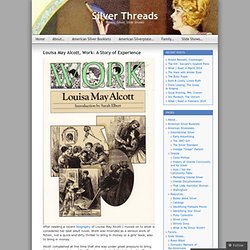
Work was intended as a serious work of fiction, not a quick-and-dirty thriller to bring in money or a girls’ book, also to bring in money. Alcott complained at the time that she was under great pressure to bring the book to market, and it suffered accordingly. Realism, Naturalism And Regionalism. Realism in American Literature. American Realism and Naturalism (F '02) Does realistic fiction represent the world as we know it, or does it imagine it as we think we'd like to see it?
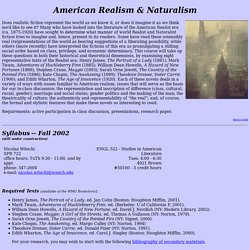
Many who have looked into the literature of the American Realist era (ca. 1875-1920) have sought to determine what manner of world Realist and Naturalist fiction tries to imagine and, hence, present to its readers. Some have read these ostensibly real (re)presentations of the world as bearing suggestions of a liberating possibility, while others (more recently) have interpreted the fictions of this era as promulgating a stifling social order based on class, privilege, and economic determinacy. Requirements: active participation in class discussion, presentations, research paper. photo credit. Moby-Dick: Plot Overview. Moby-Dick: Themes, Motifs & Symbols. Themes Themes are the fundamental and often universal ideas explored in a literary work.

The Limits of Knowledge As Ishmael tries, in the opening pages of Moby-Dick, to offer a simple collection of literary excerpts mentioning whales, he discovers that, throughout history, the whale has taken on an incredible multiplicity of meanings. Over the course of the novel, he makes use of nearly every discipline known to man in his attempts to understand the essential nature of the whale. Each of these systems of knowledge, however, including art, taxonomy, and phrenology, fails to give an adequate account. 19th Century Science and Literature timeline. 19th Century America Timeline timeline. Sentimental novel. Sentimental novels relied on emotional response, both from their readers and characters.
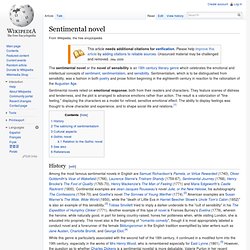
They feature scenes of distress and tenderness, and the plot is arranged to advance emotions rather than action. The result is a valorization of "fine feeling," displaying the characters as a model for refined, sensitive emotional effect. The ability to display feelings was thought to show character and experience, and to shape social life and relations.[1] History[edit] Uncle Tom's Cabin. Uncle Tom's Cabin; or, Life Among the Lowly,[1][2] is an anti-slavery novel by American author Harriet Beecher Stowe.
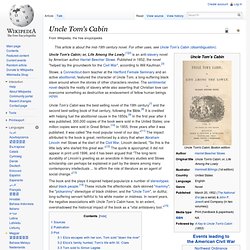
Uncle Tom’s Cabin. Narrative of the Life of Frederick Douglass: Analysis of Major Characters. Frederick Douglass.
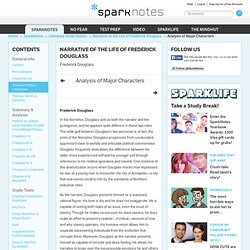
Uncle Tom's Homepage. Plots & Characters. (Hamden, CT: Archon Books, 1978) Placed on line with the kind permission of the author and publisher.
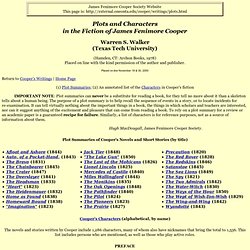
Placed on-line November 18 & 30, 2000 Return to Cooper's Writings | Home Page (1) Plot Summaries; (2) An annotated list of the Characters in Cooper's fiction IMPORTANT NOTE: Plot summaries can never be a substitute for reading a book, for they tell no more about it than a skeleton tells about a human being. The purpose of a plot summary is to help recall the sequence of events in a story, or to locate incidents for re-examination. Hugh MacDougall, James Fenimore Cooper Society. Wilderness in The Pioneers « AML 4453: Visions of the Land. Wilderness in The Pioneers James Fenimore Cooper’s The Pioneers provides a lengthy, highly descriptive depiction of early American wilderness.

In particular, Cooper characterizes the wilderness as an overwhelmingly male entity, and a place for males to explore. In chapter four (“Wilderness”) of Garrard’s Ecocriticism, he explains that “feminist critics have shown that the qualities associated with the sublime and beautiful are gendered…as the feminine and beautiful is denigrated by comparison with the masculine sublime…so women are excluded from encounters with the wild,” (Garrard 64). The Octopus by Frank Norris - Waldo's Reading Notes. The Conjure Woman by Charles Waddell Chesnutt.
Charles Waddell CHESNUTT (1858 - 1932) Published in 1899 by Houghton Mifflin, Chesnutt's first book, The Conjure Woman, was a collection of seven short stories, all set in "Patesville" (Fayetteville), North Carolina.

While drawing from local color traditions and relying on dialect, Chesnutt's tales of conjuring, a form of magic rooted in African hoodoo, refused to romanticize slave life or the "Old South. " Though necessarily informed by Joel Chandler Harris's popular Uncle Remus stories and Thomas Nelson Page's plantation fiction, The Conjure Woman consciously moved away from these models, instead offering an almost biting examination of pre- and post-Civil War race relations. These seven short stories use a frame narrator, John, a white carpetbagger who has moved south to protect his wife Annie's failing health and to begin cultivating a grape vineyard.
Enamored by remnants of the plantation world, John portrays the South in largely idealistic terms. Language: English. American Literature: Realism timeline. 19th-Century American Literature : Saint Louis University College_of_Arts_and_Sciences. The following list of literary and critical works, ranging from the beginning of the nineteenth century and into the first decade of the twentieth, is designed with two general goals in mind.
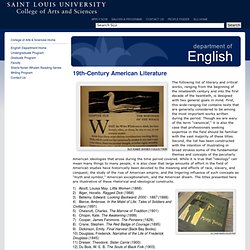
First, this wide-ranging list contains texts that are generally considered to be among the most important works written during the period. Though we are wary of the term "canonical," it is also the case that professionals seeking expertise in the field should be familiar with the vast majority of these titles. Second, the list has been constructed with the intention of illustrating in broad strokes some of the fundamental themes and concepts of the peculiarly American ideologies that arose during the time period covered. 1) Alcott, Louisa May, Little Women (1868) 2) Alger, Horatio. Regionalism and Realism in 19th Century American Literature. Regionalism and Realism in 19 th Century American Literature In century America the Civil War and westward expansion created numerous changes in society and politics.
American artists turned to realism and regionalism to comment on the new concerns of the time period such as the ongoing struggle of the working class as well as the societal elevation of the middle class. Artists documented these national transformations by creating removed, impartial depictions of everyday life.